‘Harsh setbacks’ overcome to open the U.S. Marshals Museum in Fort Smith
by June 29, 2023 3:02 pm 1,603 views
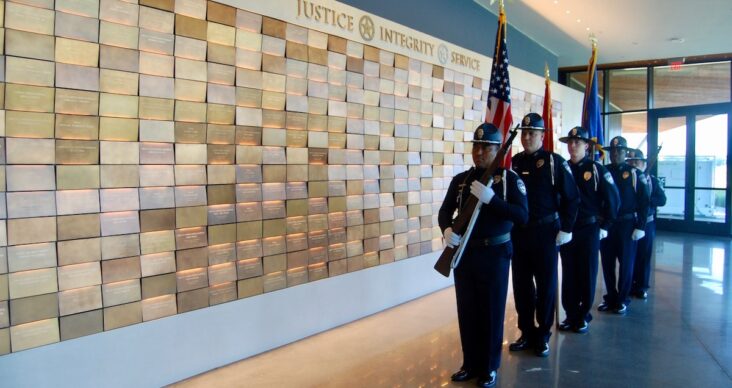
The Fort Smith Police Department Color Guard stand near the Samuel M. Sicard Hall of Honor prior to the beginning of Thursday’s (June 29) ceremonial opening of the U.S. Marshals Museum.
The relief was palpable among many of the 350 who gathered Thursday (June 29) to open the U.S. Marshals Museum in Fort Smith. It was a project 16 years in the making. Doug Babb said what is now a “glorious opening” was a “difficult task” and sometimes felt like an “impossible dream.”
Babb, chair of the U.S. Marshals Museum Board of Directors, said a year after it was announced Fort Smith was selected as the museum site, the Great Recession hit. That would be among several “extremely harsh setbacks” during the process to fund and build the national museum, Babb told the crowd.
“We had a difficult task. We had to raise $50 million,” Babb said, adding that “Today, our dream is a reality, and I thank you all for that.”
It has been a struggle, or, as Babb noted, a “16-year relay race” among many leaders, donors, volunteers and others who worked to raise money, awareness and, often, push back against pessimists who doubted it would ever happen.
In January 2007, the U.S. Marshals Service selected Fort Smith as the site for the national museum. The Robbie Westphal family, led by Bennie Westphal and Robin Westphal Clegg, donated the riverfront land for the museum. A ceremonial groundbreaking was held in September 2015. Museum officials initially hoped to have the facility open by late 2017, but struggles to raise money delayed the opening. Construction of the approximately 53,000-square-foot U.S. Marshals Museum was completed — except for exhibits — in early 2020.
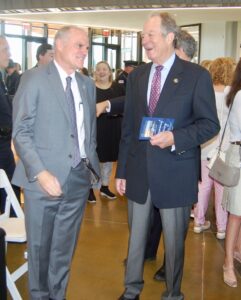
The museum, in late 2021, was also hit with a leadership problem when Patrick Weeks was arrested on Dec. 21 on two felony charges of aggravated assault with a firearm. Weeks, who was hired as museum president and CEO in June 2014, resigned after the charges were made public. Museum President and CEO Ben Johnson was hired in August 2022.
According to the museum, the facility’s exterior features a modified star-shaped design signifying the star badge worn by U.S. Marshals. The museum is designed to tell the story of the United States’ oldest federal law enforcement agency, which was established by President George Washington. The interior has five “immersive galleries” that provide information about the role Marshals have played in U.S. history. The galleries are: To Be A Marshal, The Campfire/Stories Under The Stars, Frontier Marshals, A Changing Nation and Modern Marshals.
The interior also includes the Samuel M. Sicard Hall of Honor, which recognizes the sacrifice of more than 370 Marshals killed in the line of duty since 1789.
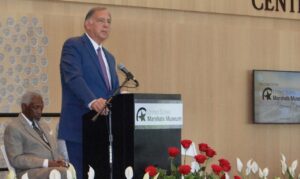
Even Robert A. Young III, former head of what is now Fort Smith-based ArcBest, and an early museum leader and major donor, told Talk Business & Politics he had moments of doubt.
“This was meant to be. This museum needed to be in Fort Smith because of the long history here with the Marshals Service and the Hanging Judge (U.S. District Court Judge Isaac Parker) and all of that history about the frontier,” Young said. “I’m so pleased that it’s open. I was beginning to think that, at times, we weren’t going to make it. But we did. And I think the community is to be congratulated for supporting this museum.”
Speaking Thursday during the opening ceremony were U.S. Sen. John Boozman, R-Ark., and U.S. Rep. Steve Womack, R-Rogers.
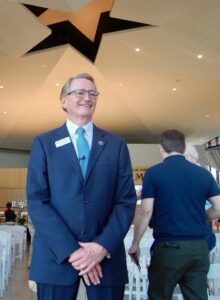
Boozman and Womack helped push the United States Marshals Service 225th Anniversary Commemorative Coin Act through Congress, and in 2016 it became one of the early sources of significant funding for the museum. Coin sales would eventually provide the museum with $3.053 million. Womack recognized former U.S. Rep. Mike Ross, D-Prescott, for helping push the coin bill.
“He picked up where I needed help,” Womack said.
Also attending Thursday’s ceremony was former U.S. Sen. Mark Pryor, D-Ark., who was part of Arkansas’ Congressional delegation that supported the coin legislation.
Other speakers included Arkansas Gov. Sarah Sanders, U.S. Marshals Service Director Ronald Davis, Fort Smith Mayor George McGill, Laurice Hachem, chair of the U.S. Marshals Museum Foundation, and Marshals Museum President and CEO Ben Johnson.
“It’s very special to be here today. This is a labor of love for many people, and it represents one of the greatest law enforcement agencies in our history,” Davis told Talk Business & Politics. “And I think it will attract a lot of attention over the years with tourism and visits because of what it represents – it’s part of the history of America. I’m very optimistic about people visiting this museum.”
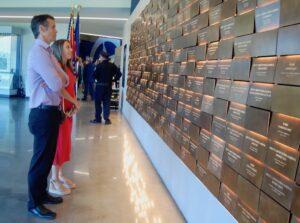
The museum will be open to the public at 9 a.m., July 1. The entry fee is $13 for adults, $8 for those ages 6-17, and free to military and law enforcement members. Johnson said he and the staff are ready to welcome the public.
“I don’t know what to expect in terms of traffic, but I hope we blow the doors off,” Johnson said. “I’m ready to earn some money and not just ask for it.”
He’s also optimistic the museum will meet visitor expectations because the museum is also about American history from the early days of the Republic.
“This is American history. This is American history through the lens of the Marshals Service. …Every single major event in American history, the U.S. Marshals Service was involved in some way,” he said.
According to a 2018 study, the museum could see around 125,000 visitors a year. The Arkansas Economic Development Institute, using information from the study, estimated the museum and related tourist expenditures would have a total annual impact on Sebastian County of $13 million to $22 million.
